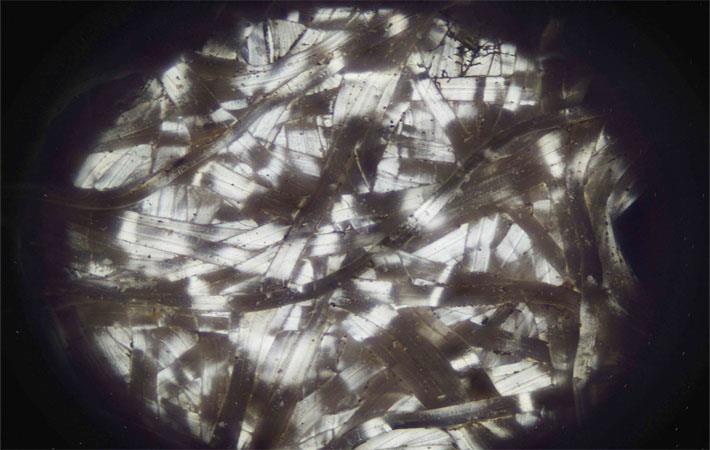Interviews
Columbia Engineering team creates comet moth fibres
09 Jun '18
5 min read

Courtesy: Norman Shi and Nanfang Yu/Columbia Engineering
Columbia Engineering scientists have found that fibres produced by the caterpillars of a wild silk moth, the Madagascar comet moth (Argema mittrei), are far superior in brilliance and cooling ability. In addition to having outstanding cooling properties, comet moth’s cocoon fibres also have exceptional capabilities for transmitting light signals and images.
Led by Nanfang Yu, associate professor of applied physics, the team characterised the optical properties associated with one-dimensional nanostructures they found in comet moth cocoon fibres. They were so fascinated by the unusual properties of these fibres that they developed a technique to spin artificial fibres that mimic the nanostructures and optical properties of the natural fibres. The study is published in Light: Science & Applications.
“The comet moth fibres are the best natural fibrous material to block sunlight we’ve ever seen. Synthesising fibres possessing similar optical properties could have important implications for the synthetic fibre industry,” said Yu, an expert in nanophotonics. “Another amazing property of these fibres is that they can guide light signals or even transport simple images from one end to the other end of the fibre. This means we might be able to use them as a biocompatible and bioresorbable material for optical signal and image transport in biomedical applications.”
While individual fibres produced by the domesticated silkworms look like solid, transparent cylinders under an optical microscope, the individual thread spun by the comet moth caterpillars has a highly metallic sheen. The comet moth fibres contain a high density of nanoscale filamentary air voids that run along the fibres and cause strong specular (mirror-like) reflection of light. A single fibre with the thickness of a human hair, about 50 microns in diameter, reflects more than 70 per cent of visible light. In contrast, for common textiles, including silk fabrics, to reach such level of reflectivity, one has to put together many layers of transparent fibres for a total thickness of about 10 times that of a single comet moth fibre. In addition, the high reflectivity of comet moth fibres extends well beyond the visible range into the infrared spectrum—invisible to the human eye but containing about half of the solar power. This, together with the fibres’ ability to absorb ultra violet (UV) light, makes them ideal for blocking sunlight, which contains UV, visible, and infrared components.
“This form of light guiding—confining light to propagate within the interior of a strand of material with no sideways light leakage—is very different from the one utilised in light transmission through undersea fibre-optic cables, where light confinement is provided by reflection at the boundary between a fibre core and a cladding layer,” said Norman Shi, lead author of the paper and a PhD student recently graduated from Yu’s lab. “This is the first time transverse Anderson localisation has been discovered in a natural materials system. Our finding opens up potential applications in light guiding, image transport, and light focusing where biocompatibility is required.”
Once Yu’s team had characterised the comet moth fibres, they then set to inventing novel fibre pulling methods that emulate the fibre spinning mechanism of the comet moth caterpillar to create fibres embedded with a high density of particulate or filamentary voids. The researchers achieved a density of voids several times higher than that found in the natural fibres: a single bioinspired fibre is able to reflect about 93 per cent of sunlight. They produced these bioinspired fibers using two materials: a natural material (regenerated silk, that is liquid precursor of silk fibres) and a synthetic polymer (polyvinylidene difluoride). While the former is suitable for applications requiring biocompatibility, the latter is suitable for high throughput production.
“The single major difference between our bioinspired fibres and fibres used universally for textiles and apparel is that the bioinspired fibres contain engineered nanostructures, whereas conventional fibres all have a solid core,” Yu said. “The capability of structural engineering on the tiny cross-section of a fibre via a high-throughput, high-yield fibre spinning process opens up a new dimension of design—we can infuse completely novel optical and thermodynamic functions into fibres and textiles composed of such fibres. We could transform the synthetic fibre industry!”
These bioinspired fibres could be used for making ultra-thin summer clothing with “air conditioning” properties. Just a few layers of the fibres could make a totally opaque textile that is a fraction of a sheet of paper in thickness. Yet it wouldn’t become translucent when the wearer sweats, which is a common problem with conventional textiles. While sweat reduces the opaqueness of common fabrics by reducing the number of fibre-air interfaces that reflect light, it would not affect the nanoscale air voids embedded in the bioinspired fibres. In addition, ultra-thin apparel made of the “porous” fibres would promote cooling through a combination of sweat evaporation, air flow between the microenvironment of the human body and the exterior, and radiation of body heat to the external environment. “Thus, your clothes could give you the ultimate cooling experience through the collective effect of evaporative, convective, and radiative cooling,” Yu added. (SV)
Led by Nanfang Yu, associate professor of applied physics, the team characterised the optical properties associated with one-dimensional nanostructures they found in comet moth cocoon fibres. They were so fascinated by the unusual properties of these fibres that they developed a technique to spin artificial fibres that mimic the nanostructures and optical properties of the natural fibres. The study is published in Light: Science & Applications.
“The comet moth fibres are the best natural fibrous material to block sunlight we’ve ever seen. Synthesising fibres possessing similar optical properties could have important implications for the synthetic fibre industry,” said Yu, an expert in nanophotonics. “Another amazing property of these fibres is that they can guide light signals or even transport simple images from one end to the other end of the fibre. This means we might be able to use them as a biocompatible and bioresorbable material for optical signal and image transport in biomedical applications.”
While individual fibres produced by the domesticated silkworms look like solid, transparent cylinders under an optical microscope, the individual thread spun by the comet moth caterpillars has a highly metallic sheen. The comet moth fibres contain a high density of nanoscale filamentary air voids that run along the fibres and cause strong specular (mirror-like) reflection of light. A single fibre with the thickness of a human hair, about 50 microns in diameter, reflects more than 70 per cent of visible light. In contrast, for common textiles, including silk fabrics, to reach such level of reflectivity, one has to put together many layers of transparent fibres for a total thickness of about 10 times that of a single comet moth fibre. In addition, the high reflectivity of comet moth fibres extends well beyond the visible range into the infrared spectrum—invisible to the human eye but containing about half of the solar power. This, together with the fibres’ ability to absorb ultra violet (UV) light, makes them ideal for blocking sunlight, which contains UV, visible, and infrared components.
“This form of light guiding—confining light to propagate within the interior of a strand of material with no sideways light leakage—is very different from the one utilised in light transmission through undersea fibre-optic cables, where light confinement is provided by reflection at the boundary between a fibre core and a cladding layer,” said Norman Shi, lead author of the paper and a PhD student recently graduated from Yu’s lab. “This is the first time transverse Anderson localisation has been discovered in a natural materials system. Our finding opens up potential applications in light guiding, image transport, and light focusing where biocompatibility is required.”
Once Yu’s team had characterised the comet moth fibres, they then set to inventing novel fibre pulling methods that emulate the fibre spinning mechanism of the comet moth caterpillar to create fibres embedded with a high density of particulate or filamentary voids. The researchers achieved a density of voids several times higher than that found in the natural fibres: a single bioinspired fibre is able to reflect about 93 per cent of sunlight. They produced these bioinspired fibers using two materials: a natural material (regenerated silk, that is liquid precursor of silk fibres) and a synthetic polymer (polyvinylidene difluoride). While the former is suitable for applications requiring biocompatibility, the latter is suitable for high throughput production.
“The single major difference between our bioinspired fibres and fibres used universally for textiles and apparel is that the bioinspired fibres contain engineered nanostructures, whereas conventional fibres all have a solid core,” Yu said. “The capability of structural engineering on the tiny cross-section of a fibre via a high-throughput, high-yield fibre spinning process opens up a new dimension of design—we can infuse completely novel optical and thermodynamic functions into fibres and textiles composed of such fibres. We could transform the synthetic fibre industry!”
These bioinspired fibres could be used for making ultra-thin summer clothing with “air conditioning” properties. Just a few layers of the fibres could make a totally opaque textile that is a fraction of a sheet of paper in thickness. Yet it wouldn’t become translucent when the wearer sweats, which is a common problem with conventional textiles. While sweat reduces the opaqueness of common fabrics by reducing the number of fibre-air interfaces that reflect light, it would not affect the nanoscale air voids embedded in the bioinspired fibres. In addition, ultra-thin apparel made of the “porous” fibres would promote cooling through a combination of sweat evaporation, air flow between the microenvironment of the human body and the exterior, and radiation of body heat to the external environment. “Thus, your clothes could give you the ultimate cooling experience through the collective effect of evaporative, convective, and radiative cooling,” Yu added. (SV)
Fibre2Fashion News Desk – India
Popular News
Leave your Comments
Editor’s Pick
Therese Premler-Andersson
Textile Machinery Association of Sweden (TMAS)
Vikash Rajpurohit
Vastra App (Charmeuse Technologies Pvt Ltd)
J Rajaraman
Canadian Solar Energy Private Limited
Amritha Ram
Brand - KH House of Khaddar
































-Ltd..jpg?tr=w-120,h-60,c-at_max,cm-pad_resize,bg-ffffff)





.jpg?tr=w-120,h-60,c-at_max,cm-pad_resize,bg-ffffff)
.jpg?tr=w-120,h-60,c-at_max,cm-pad_resize,bg-ffffff)






